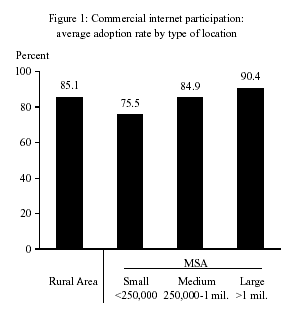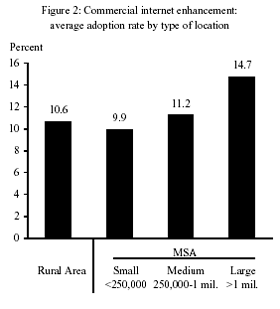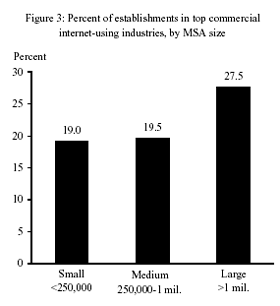In just about ten years or so, the commercial use of the internet has metamorphosed from a researcher’s tool to an everyday business necessity. Indeed, a large fraction of the boom in business investment in information technology (IT) was related to business applications and infrastructure using internet-related technology.
- Commercial uses of the internet: participation and enhancement
- Urban leadership in internet use?
- The role of industry composition
- The marginal effects of location
- Conclusions
- References
|
In just about ten years or so, the commercial use of the internet has metamorphosed from a researcher’s tool to an everyday business necessity. Indeed, a large fraction of the boom in business investment in information technology (IT) was related to business applications and infrastructure using internet-related technology.
As more and more firms adopted internet-related technology, many forecasters predicted that the internet would change both the way Americans do business and where they do business. Essentially, the predictions presented two possible scenarios on the latter point. In one scenario, the internet would bring firms together into a single “global village,” suggesting internet technology would diffuse more quickly to rural areas than to urban areas. The argument for this scenario is that the internet decreases coordination costs within firms and between firms, which reduces the importance of distance; and internet technology dramatically reduces the costs of performing isolated economic activity, particularly in rural settings. In the other scenario, the diffusion of the commercial internet would follow the historical pattern of “urban leadership.” The argument for this scenario is that the internet, like many other IT innovations, requires complementary infrastructure and support services, which are more readily available in urban settings. This scenario is often used to argue that there is a geographic “digital divide” favoring larger urban areas in commercial internet use.
This Economic Letter summarizes research (Forman, Goldfarb, and Greenstein 2003a, 2003b) finding that the use of basic internet technology is widely dispersed among both urban and rural locations. Moreover, although advanced internet technology was adopted most rapidly in large urban areas, the research finds that much (but not all) of the apparent “digital divide” in internet use can be explained by the heavy concentration of internet-intensive industries in large urban areas.
Commercial uses of the internet: participation and enhancement
The most common yardstick for measuring new technology use is the rate of adopting the technology’s applications. Forman, Goldfarb, and Greenstein (2003a) conducted a census on firms’ adoption of internet technology using data on establishments. An establishment is a single point of contact for a business, usually using a single mailing address. Most large firms have multiple establishments, in which case they appear in our study multiple times. We analyzed the dispersion of use of the internet in two distinct layers, participation and enhancement.
Participation is associated with the adoption of basic communications, like e-mail use, browsing, and passive document sharing. It also represents our measure of the basic internet investment required to do business. This was easy to measure.
Next we measured the adoption of internet technology as a means of enhancing sophisticated business computing processes. In spirit, enhancement uses internet technologies to change existing internal operations or to introduce new services. Examples of our measure of enhancement include electronic commerce transactions with value chain partners and final purchasers as well as internet-enabled internal business applications, like enterprise resource planning.
To measure both layers, we used data from the Harte Hanks Market Intelligence CI Technology database, a private survey of technology use that includes firms in the manufacturing and services sectors. Our final sample included 86,879 commercial establishments with 100 or more employees at the end of 2000, and we used routine statistical methods to project our results to all establishments in the U.S. with over 100 employees. This covers the workplaces for two-thirds of the U.S. labor force.



Urban leadership in internet use?
The overall rates of adoption for participation and enhancement differ widely. Participation use is widespread across the U.S. economy, adopted by 88.6% of establishments when projected on to the true distribution of establishments in the economy. In contrast, levels of enhancement are much lower, adopted by 12.6% of establishments.
Figure 1 shows the rates at which establishments adopt participation and enhancement across U.S. metropolitan statistical areas (MSAs) of varying sizes. Although each type of location shows a high rate of adoption for participation, the rate of adoption increases with location size.
The disparities in enhancement adoption rates are even greater. The results displayed in Figure 2 show that large MSAs have the highest average adoption rates, almost one-third greater than medium MSAs and nearly 40% higher than rural areas. These simple differences in averages suggest that the diffusion of internet technology followed a traditional urban leadership pattern. However, looks can be deceiving.
The role of industry composition
It is well known that certain industries tend to be concentrated in different parts of the country—automakers in the Detroit area, film production and distribution in the Los Angeles area, and financial services in New York, just to cite a few.
Our results suggest another kind of concentration; specifically we find that the mix of industries with the highest enhancement adoption rates tends to be in the biggest cities. These industries include management of companies and enterprises, media, telecommunications and data processing, utilities, finance and insurance, professional, scientific and technical services, and wholesale trade.
Our method of obtaining this result involved calculating the fraction of the number of these leading establishments (in terms of enhancement adoption) over the total number of establishments in an MSA; to calculate leading establishments, we used the top quartile of adopters. The results are displayed in Figure 3, and they suggest that industry composition accounts for much of the difference in adoption rates between smaller and larger MSAs.
The marginal effects of location
To test whether patterns of adopting the internet are consistent with the global village or urban leadership view, we need to separate the effects of location from the effects of industry composition. Therefore, we examined the marginal effects of location on establishment adoption decisions. These marginal effects answer the question, “How does location influence internet adoption, controlling for an establishment’s size and industry?” Roughly speaking, marginal effects enable us to identify whether moving the same establishment from Chicago to Peoria had an impact on its likelihood of adopting the internet.
In Forman, Goldfarb, and Greenstein (2003b), we controlled for an establishment’s industry and showed that urban leadership does not describe establishment adoption of participation technology. If anything, a mild form of the global village view seems more evident. Medium-sized and large MSAs are 0.5% to 1.0% less likely to have adopted participation than those in rural areas by the end of 2000. However, these effects are relatively small compared to average participation rates of 88.6%. Overall, for simple technologies, some of the internet’s promise to reduce the costs of distance seems to hold.
We reach the opposite conclusion for enhancement. Even with industry controls, the pattern of adoption is more consistent with the urban leadership view than the global village view. Establishments in medium-sized and large MSAs adopt enhancement at a rate 0.8% to 1.1% higher than do rural areas. These differences are economically significant in light of the overall enhancement rates of 12.6%.
The dichotomy in diffusion patterns between simple and complex technologies is consistent with recent work that has emphasized the importance of adaptation costs to the adoption of “general purpose” technologies like the internet. To be specific, adoption of the internet involves substantial costs to adapt a general technology to idiosyncratic business needs. This adaptation often involves third-party support and complementary services—often IT services firms and systems integrators—who will be most commonly found in urban areas. Moreover, these complementary services will be most important for complex applications like enhancement. As a result, we interpret the differences in adoption patterns between participation and enhancement as evidence that applications more dependent on third-party support are most costly to deploy in less dense locations.
Has the use of internet technology by businesses been greater in urban areas—following the geographic diffusion pattern of earlier computing technologies—and has it thereby exacerbated local differences in the potential for economic growth? Or, as a communications technology, has the diffusion of the internet been more consistent with the view that it reduces the importance of distance to economic activity?
Our research shows that there are elements of both the global village and urban leadership views in the geographic pattern of internet adoption. By 2000, participation activities like e-mail and web browsing had diffused almost everywhere, indicating that the pattern for participation adoption is better explained by the global village view. In contrast, for complex enhancement technologies, adoption behavior is better explained by urban leadership theory; this pattern makes economic sense, because it could arise from thin technical labor markets in smaller MSAs and rural areas, which would drive up the costs of operating facilities using internet technology.
The answers to these questions are important because of their implications for regions’ comparative advantage. Concentration of internet use—as implied by urban leadership—may increase short-run urban/rural differences in productivity. In the longer run, inexpensive communications may mean that establishments relocate from high-cost/high-density areas to low-cost/low-density areas. These remain open questions, however. Future work should compare the location decisions in industries where internet use is prevalent with those in other industries. This will help complete the picture of how the internet affects geographic variance in productivity and employment.
Chris Forman
Assistant Professor, Tepper School of Business, Carnegie Mellon University, and CSIP Visiting Scholar
Avi Goldfarb
Assistant Professor, Rotman School of Management, University of Toronto
Shane Greenstein
Elinor and Wendell Hobbs Professor, Kellogg School of Management, Northwestern University
[URLs accessed August 2004.]
Forman, Chris, Avi Goldfarb, and Shane Greenstein. 2003a. “The Geographic Dispersion of Commercial Internet Use.” In Rethinking Rights and Regulations: Institutional Responses to New Communications Technologies, eds. Lorrie Faith Cranor and Steven S. Wildman. Cambridge, MA: MIT Press.
Forman, Chris, Avi Goldfarb, and Shane Greenstein. 2003b. “How Did Location Affect Adoption of the Commercial Internet? Global Village, Urban Leadership, and Industry Composition.” NBER Working Paper #9979.
Opinions expressed in FRBSF Economic Letter do not necessarily reflect the views of the management of the Federal Reserve Bank of San Francisco or of the Board of Governors of the Federal Reserve System. This publication is edited by Anita Todd and Karen Barnes. Permission to reprint portions of articles or whole articles must be obtained in writing. Please send editorial comments and requests for reprint permission to research.library@sf.frb.org